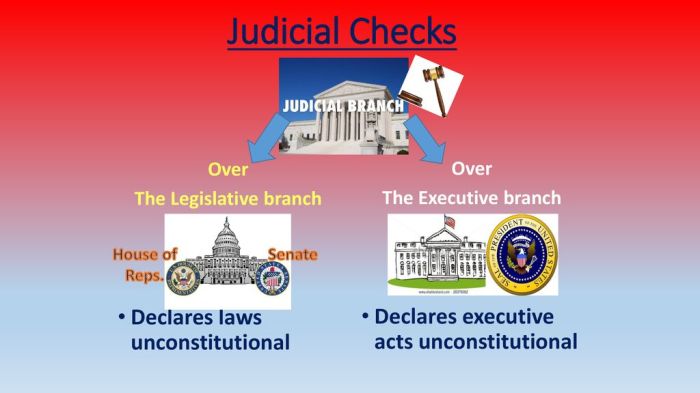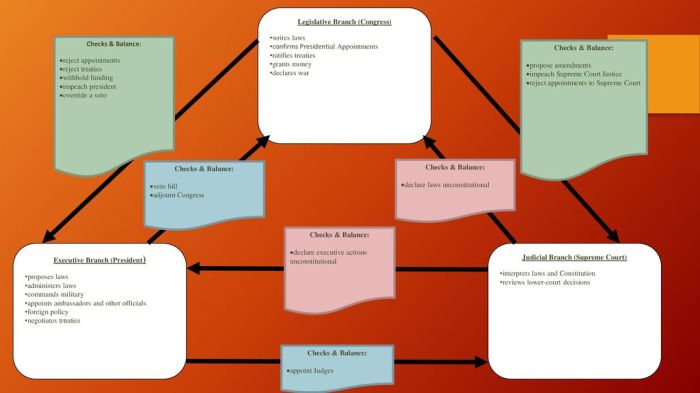
Which branch declares laws unconstitutional? This fundamental question lies at the heart of American democracy, shaping the very fabric of our nation’s legal system. The answer, as established in the landmark case Marbury v. Madison (1803), rests with the judicial branch, specifically the Supreme Court. This principle, known as judicial review, grants the court the power to strike down laws deemed incompatible with the Constitution, acting as a vital safeguard against governmental overreach.
The concept of judicial review, while seemingly straightforward, is deeply complex and multifaceted. It involves a delicate balancing act between the power of the government and the rights of the people, ensuring that the laws of the land remain consistent with the principles enshrined in the Constitution. Through its power of judicial review, the Supreme Court has played a pivotal role in shaping American society, from protecting individual liberties to upholding the rule of law.
The Power of Judicial Review

Judicial review is a fundamental principle of the United States legal system, granting the judiciary the authority to review laws and actions of the executive and legislative branches to determine their constitutionality. This power ensures that the government operates within the confines of the Constitution and protects individual rights.
Historical Development of Judicial Review
The concept of judicial review evolved gradually, drawing inspiration from English common law and the writings of prominent thinkers like Montesquieu and Blackstone. While the Constitution doesn’t explicitly mention judicial review, it implicitly grants the judiciary the power to interpret its provisions.
Marbury v. Madison (1803), Which branch declares laws unconstitutional
The landmark case of *Marbury v. Madison* (1803) established judicial review as a cornerstone of American jurisprudence. The case involved a dispute over the appointment of William Marbury as a justice of the peace. Chief Justice John Marshall, in his opinion, declared a provision of the Judiciary Act of 1789 unconstitutional, thereby asserting the Supreme Court’s power to strike down laws inconsistent with the Constitution.
“It is emphatically the province and duty of the Judicial Department to say what the law is.” – Chief Justice John Marshall, *Marbury v. Madison*
Examples of Judicial Review in Action
Throughout history, the Supreme Court has used judicial review to declare numerous laws unconstitutional. Some notable examples include:
- Brown v. Board of Education (1954): This landmark case declared state laws establishing separate public schools for black and white students unconstitutional, overturning the *Plessy v. Ferguson* (1896) decision and paving the way for desegregation.
- Roe v. Wade (1973): The Court recognized a constitutional right to privacy, protecting a woman’s right to choose to have an abortion during the early stages of pregnancy.
- Obergefell v. Hodges (2015): The Court legalized same-sex marriage nationwide, recognizing the fundamental right to marry as a basic civil right.
The Process of Judicial Review

The process of judicial review is complex and involves several stages, starting with a case being brought before the Supreme Court. Understanding how cases reach the Supreme Court and the different types of opinions issued by the Court is crucial to understanding the application of judicial review.
The Path to the Supreme Court
A case can reach the Supreme Court through various routes. The most common way is through an appeal from a lower court, either a federal court of appeals or a state supreme court. For a case to be heard by the Supreme Court, it must first be considered by a lower court. If the party who lost in the lower court disagrees with the decision, they can appeal the case to a higher court.
The Supreme Court has discretion over which cases it chooses to hear. The Court receives thousands of petitions for review each year, but it only agrees to hear a small percentage. The Justices consider several factors when deciding whether to grant certiorari, which is the process of agreeing to hear a case.
The Court may be more likely to hear a case if:
- The case involves a significant legal issue.
- The case presents a conflict between different lower courts’ decisions.
- The case involves a question of national importance.
Types of Supreme Court Opinions
Once the Supreme Court hears a case, the Justices issue an opinion that explains the Court’s decision. There are three main types of opinions:
- Majority Opinion: This opinion represents the majority of the Justices’ votes. It is the official decision of the Court and sets the legal precedent for future cases.
- Dissenting Opinion: Justices who disagree with the majority opinion can write a dissenting opinion to explain their reasoning. Dissenting opinions do not change the outcome of the case, but they can influence future legal developments.
- Concurring Opinion: Justices who agree with the majority opinion but for different reasons can write a concurring opinion. Concurring opinions can provide additional insights into the Court’s reasoning and can sometimes influence future legal decisions.
Criteria for Determining Unconstitutionality
The Supreme Court uses several criteria to determine whether a law is unconstitutional. The Court examines the law in light of the Constitution, considering the text, history, and purpose of the Constitution. The Court also considers relevant precedents and the arguments presented by the parties in the case.
The Court has identified several key principles that it uses to determine whether a law is unconstitutional. These principles include:
- Separation of Powers: The Constitution establishes a system of checks and balances among the three branches of government. The Court will strike down laws that violate the separation of powers principle, such as laws that give Congress too much power or that interfere with the President’s executive authority.
- Federalism: The Constitution divides power between the federal government and the states. The Court will strike down laws that violate the principles of federalism, such as laws that intrude on areas reserved for the states.
- Individual Rights: The Constitution protects certain individual rights, such as freedom of speech, religion, and the press. The Court will strike down laws that violate these rights.
- Due Process: The Fifth and Fourteenth Amendments to the Constitution guarantee due process of law. The Court will strike down laws that violate due process, such as laws that are unfair or arbitrary.
- Equal Protection: The Fourteenth Amendment guarantees equal protection of the laws. The Court will strike down laws that violate equal protection, such as laws that discriminate against certain groups of people.
Final Review: Which Branch Declares Laws Unconstitutional

The power of judicial review, though controversial at times, remains a cornerstone of American democracy. It empowers the judiciary to act as a check on the legislative and executive branches, ensuring that no single branch becomes too powerful. While the judicial branch holds this weighty responsibility, it is not without its limitations. The process of judicial review is complex and involves careful consideration of legal arguments, precedents, and societal values. Ultimately, the power of judicial review serves as a vital mechanism for safeguarding the Constitution and ensuring a just and equitable society.
Questions and Answers
What are some examples of laws that have been declared unconstitutional?
The Supreme Court has declared many laws unconstitutional throughout history, including laws that violated individual rights, such as freedom of speech, religion, and the press, as well as laws that discriminated against certain groups based on race, gender, or other factors.
How does the Supreme Court decide whether a law is unconstitutional?
The Supreme Court uses a variety of criteria to determine whether a law is unconstitutional, including the text of the Constitution, previous Supreme Court rulings, and the intent of the framers of the Constitution.
Can the Supreme Court overturn its own rulings?
Yes, the Supreme Court can overturn its own rulings, though it is rare. This is known as “overruling precedent.” The Court has the power to reinterpret the Constitution and adapt its rulings to changing societal values.
What is the role of the dissenting justices in a Supreme Court decision?
Dissenting justices disagree with the majority opinion in a case and write their own opinions explaining their reasoning. These dissenting opinions can be influential in shaping future legal arguments and potentially lead to the overturning of a previous decision.




